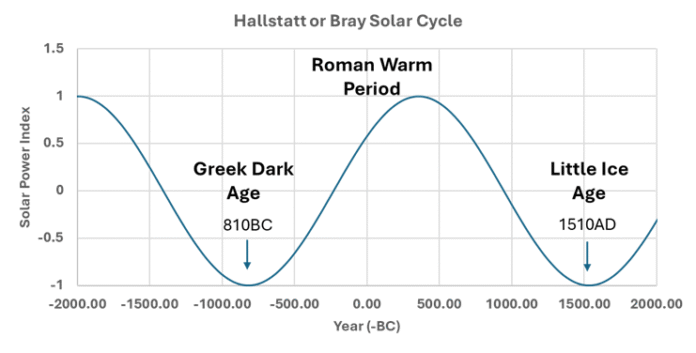By Andy May
My last post on the AMO and HadCRUT5 generated some interest and some criticism. As I explained, there are two common methods of computing the AMO index. One is to fit a least squares line to the AMO SSTs (sea surface temperatures in the North Atlantic) and use the line to detrend the AMO, creating an index. This was the original methodology as described by Enfield, et al. and Gray, et al. It is the method I prefer because it makes no assumptions about the origin of the increasing SSTs in the North Atlantic.
The other method, recommended by Trenberth & Shea, is to subtract the GMST (global mean surface temperature anomaly) from the AMO temperature anomaly. They believe this is better because the GMST warming is due to “anthropogenic changes” which mask the natural AMO oscillation. Thus, they assume global warming is entirely man-made and can “fix” the AMO by subtracting it. After subtracting the GMST, there is still an oscillation, but it is reduced in amplitude (Trenberth & Shea, 2006).
Trenberth and Shea further criticize the original AMO index as having no physical meaning. While this is true, it is also unbiased and not tainted with unwarranted assumptions about the cause of global warming. In this post we will show that the long-term trend evident in the raw North Atlantic sea surface temperature record can also be removed using the well-documented Bray Solar Cycle. The long-term signal observed since the Little Ice Age ended in 1850 may be due to increasing solar activity, at least in part. I am not saying that the Bray Solar Cycle is the cause of the long-term warming within the raw AMO region SST data, I’m just saying it could be. This invalidates Trenberth and Shea’s assumption that human activities are the cause. It is their assumption that is in question.
In May & Crok (download the final submitted version here), we used the common NOAA/Kaplan AMO region unsmoothed actual AMO temperature record before detrending. Figure 1 shows the raw and unsmoothed ERSST v5 data for the AMO North Atlantic region (equator to 70N), the ERSST record for the AMO region is similar to the NOAA/Kaplan record. The HadSST 4.1 is different because it is not infilled and has gaps that jump around with time (see figure 3 here).

James Bray first described the Bray climate cycle in a classic paper in Nature in 1968. For more complete discussions of the Bray climate and solar cycle see here and here. He used fossil evidence of glacial advances and retreats around the world to show there was a distinct pattern of changes that was around 2500 years in length. He speculated, based on sunspot and auroral records that a matching solar cycle existed. Much later Ilya Usoskin established the Hallstatt or Bray solar cycle using 14C and 10Be cosmogenic isotope records that reflect solar activity. Usoskin found that the most likely recent Bray cycle low periods were centered about 1510AD and 810BC. We used these dates and a cosine function to create the Bray trend shown in figure 1. A plot showing both “Bray low” cold periods and more of the Bray solar cycle is shown in figure 2. Figure 2 is very oversimplified, figure 2 here provides more detail.

The computed trend hits its low points near Usoskin’s dates (±20 years) and is arbitrarily scaled from -1 to 1. We are not saying that all multi-century climate trends are due to the Bray Cycle or that it acts alone, long-term climate changes involve many complex factors (see here). This post is simply contesting Trenberth and Shea’s anthropogenic assumption and offers a simple, but plausible alternative. Trenberth and Shea did not consider that changes in the Sun may have contributed to recent warming.
In figure 3 we show the ERSST v5 AMO region SSTs detrended using the light blue dotted least squares line shown in figure 1.

In figure 4 we detrended the ERSST v5 AMO region SSTs with the Bray solar cycle line shown in orange in figure 1. The result is very similar to that shown in figure 3. They are not exactly the same and some of the difference between the two may be due to human activities or emissions, but the main point is that there is no reason to assume global warming is 100% human caused. Changes in solar activity that have been documented by James Bray and Ilya Usoskin and their colleagues could have caused some of the longer-term warming evident in the raw North Atlantic SSTs shown in figure 1.

The Bray Solar cycle trend shown is dimensionless and not a proper trend to use in detrending the AMO region, but thermometers did not exist in 1520AD in the depths of the Little Ice Age or in 810BC at the end of the Greek Dark Age so there is little we can do about that. The main point is that the Bray climate and solar cycles are well established and because of them a natural long-term warming trend is expected today. There are other long solar cycles, such as the 1,000-year Eddy cycle (see the yellow bars in figures 1, 2 & 5 here), but the Bray cycle is the strongest. The Eddy cycle is increasing currently as well and may be a factor in the current longer-term warming.
The Trenberth & Shea assumption that all global warming today is human-caused and should be removed from AMO index is unsubstantiated. It is just as likely that part of the longer-term warming trend is natural and due to increasing solar activity. Solar radiation can penetrate the ocean surface and warm the Atlantic to a depth of 100 meters or more. Greenhouse gas radiation cannot penetrate the ocean surface and causes much less warming of the ocean surface as a result. Thus, Watt per Watt, solar radiation is more effective, by a factor of 4 to 7 times according to Judith Lean, at warming the North Atlantic, a point often missed by the climate “consensus.”
Bray, J. R. (1968). Glaciation and Solar Activity since the Fifth Century BC and the solar cycle. Nature, 220. Retrieved from https://www.nature.com/articles/220672a0
Enfield, D., Mestas-Nunez, A. M., & Trimble, P. (2001). The Atlantic multidecadal oscillation and its relation to rainfall and river flows in the continental U.S. Geophysical Research Letters, 28(10). Retrieved from https://agupubs.onlinelibrary.wiley.com/doi/pdfdirect/10.1029/2000GL012745
Gray, S. T., Graumlich, L. J., Betancourt, J. L., & Pederson, G. T. (2004). A tree-ring based reconstruction of the Atlantic Multidecadal Oscillation since 1567 A.D. Geophys. Res. Lett., 31. doi:10.1029/2004GL019932
May, A., & Crok, M. (2024, May 29). Carbon dioxide and a warming climate are not problems. American Journal of Economics and Sociology, 1-15. doi:10.1111/ajes.12579
Trenberth, K., & Shea, D. (2006). Atlantic hurricanes and natural variability in 2005. Geophysical Research Letters, 33. Retrieved from https://agupubs.onlinelibrary.wiley.com/doi/pdf/10.1029/2006GL026894
Usoskin, I. G., Gallet, Y., Lopes, F., Kovaltsov, G. A., & Hulot, G. (2016). Solar activity during the Holocene: the Hallstatt cycle and its consequence for grand minima and maxima. Astronomy and Astrophysics, 587. doi:10.1051/0004-6361/201527295
Related
Discover more from Watts Up With That?
Subscribe to get the latest posts sent to your email.



